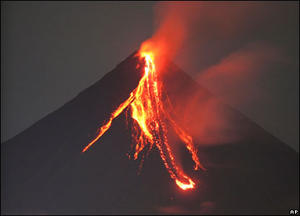Chile earthquakeChile quake will likely be followed by increased volcanic activity
Chile’s problems are not over, as previous earthquakes were followed by volcanic activity: after a magnitude 8.3 in 1906 and a magnitude 9.5 earthquake in 1960, there were three or four more volcanic eruptions within about 500 kilometers of the epicenter in the following year than would normally be expected

Volcanic activity may increase following a major earthquake // Source: listsergeant.com
Chile’s problems are not over yet. Besides aftershocks, Chile’s magnitude 8.8 earthquake on 27 February may also leave a legacy of volcanic explosions. “We expect to see an upsurge in volcanic activity over the next 12 months,” says David Pyle, a volcanologist at the University of Oxford.
Kate Ravilious writes that Charles Darwin was among the first people to suggest a link between large earthquakes and increased volcanic activity. In his records, he notes that a large earthquake off Chile’s coastline in February 1835 appeared to resurrect previously inactive volcanoes, and cause active ones to increase their eruption rates.
Last year, Pyle and his colleagues confirmed that this was a real effect in Chile, showing that increases in volcanic activity have occurred following other large earthquakes along its coastline. In particular, they found that after a magnitude 8.3 in 1906 and a magnitude 9.5 earthquake in 1960, there were three or four more volcanic eruptions within about 500 kilometers of the epicenter in the following year than would normally be expected.
Last week’s earthquake occurred on the same section of fault that caused the earthquake Darwin observed in 1835. “We’ll be using satellite measurements of heat and deformation to keep an eye on the entire arc of volcanoes, from Llaima in the south to Tupungatito in the north,” says Pyle.
Pyle stresses that the risk to local people from this extra volcanism is likely to be minimal. “At volcanoes that are already active we might see an increase in steam explosions, but we don’t expect it to present a significantly increased danger,” he says.
